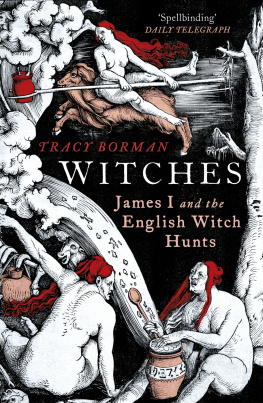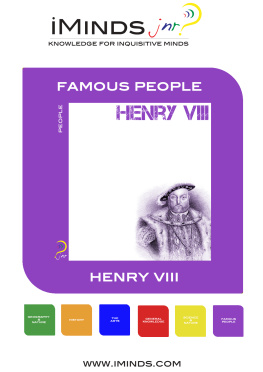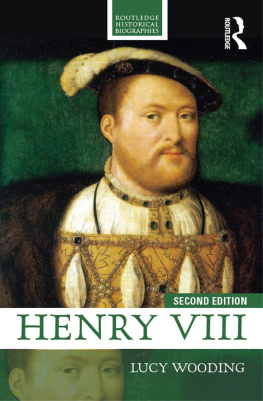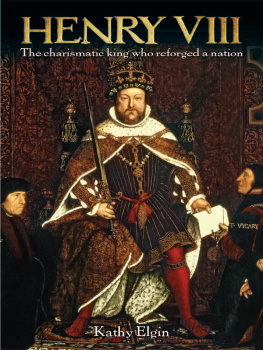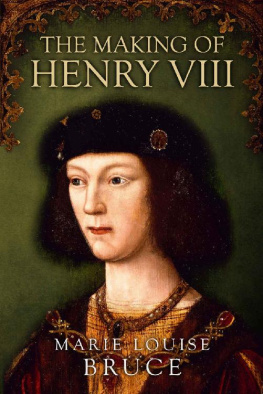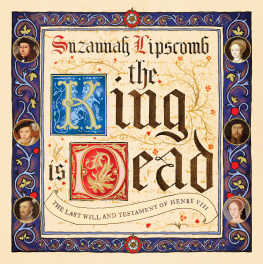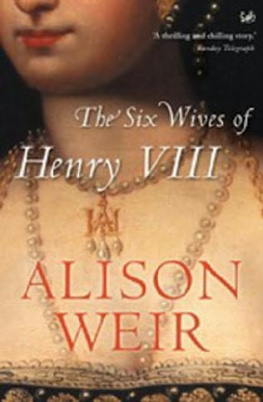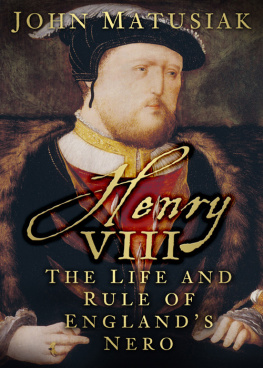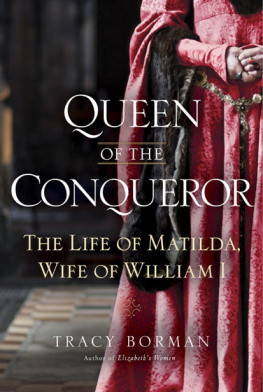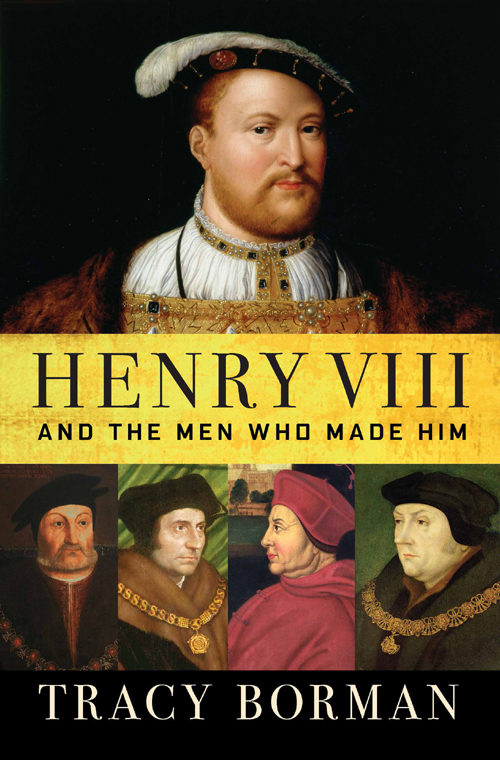HENRY VIII
AND THE MEN WHO MADE HIM
TRACY BORMAN

Copyright 2018 by Tracy Borman
Cover design by Gretchen Mergenthaler
Cover artwork: (front, clockwise from top) Henry VIII (1491-1547), Cleve, Joos van (c.1485-1541)/Burghley House Collection, Lincolnshire, UK/Bridgeman Images; Lord Cromwell, Wearing the Order of St George, Holbein, Hans (1497/8-1543) (school of )/The Trustees of the Weston Park Foundation, UK/Bridgeman Images; Cardinal Wolsey, Strong, Sampson (c.1550-1611) (after) / Ipswich Borough Council Museums and Galleries, Suffolk, UK/Bridgeman Images; Portrait of Sir Thomas More (1478-1535), Holbein the Younger, Hans (1497/8-1543) (after)/National Portrait Gallery, London, UK/Bridgeman Images; Charles Brandon, 1st Duke of Suffolk (1484-1545), Holbein the Younger, Hans (1497/8-1543) (after)/The Vyne, Hampshire, UK /National Trust Photographic Library/Bridgeman Images
All rights reserved. No part of this book may be reproduced in any form or by any electronic or mechanical means, including information storage and retrieval systems, without permission in writing from the publisher, except by a reviewer, who may quote brief passages in a review. Scanning, uploading, and electronic distribution of this book or the facilitation of such without the permission of the publisher is prohibited. Please purchase only authorized electronic editions, and do not participate in or encourage electronic piracy of copyrighted materials. Your support of the authors rights is appreciated. Any member of educational institutions wishing to photocopy part or all of the work for classroom use, or anthology, should send inquiries to Grove Atlantic, 154 West 14th Street, New York, NY 10011 or .
Printed in the United States of America
First published in Great Britain in 2018 by Hodder & Stoughton
An Hachette UK company
First Grove Atlantic Edition: January 2019
Library of Congress Cataloging-in-Publication data available for this title.
ISBN 978-0-8021-2843-0
eISBN 978-0-8021-4640-3
Atlantic Monthly Press
an imprint of Grove Atlantic
154 West 14th Street
New York, NY 10011
Distributed by Publishers Group West
groveatlantic.com
19 20 21 22 10 9 8 7 6 5 4 3 2 1
For John Ashworth, with love
The son was born to a greater destiny
In 1537, King Henry VIII instructed his favourite court painter, Hans Holbein, to begin work on a huge mural to decorate the wall of his privy chamber at Whitehall Palace. The timing was significant. Henry had just emerged from one of the most testing years of his reign. A jousting accident had left him with a painful, debilitating wound to his leg, which provided a salient reminder of his mortality. The failure of his second wife, Anne Boleyn, to give him a male heir had resulted in her execution. As yet there was no sign that her successor Jane Seymour would fare any better, which cast doubt upon the kings virility. Meanwhile, the turbulence of Henrys religious reforms had sparked widespread rebellion, shaking his belief in the unquestioning love of his subjects. Little wonder that Holbein was now tasked to create an image of kingly and dynastic invincibility.
It would be Holbeins most ambitious commission to date. Although the finished mural was destroyed by fire in 1698, the details have been passed down to us, thanks to a copy that was made for Charles II, as well as to the cartoon that Holbein used for transferring the composition to the wall. It was intended to project the might of the Tudor dynasty, and showed Henry flanked by his wife and his late parents, Henry VII and Elizabeth of York.
Visitors to the privy chamber at Whitehall were overawed by the life-sized image of the king that faced them as soon as they walked through the door. Henry stood there, majestic in his splendour so lifelike that the spectator felt abashed, annihilated in its presence.towards an ornate dagger that hangs at his waist. He is gloriously arrayed in sumptuous clothes and glittering jewels, and his large codpiece and heavily padded shoulders leave no doubt as to his strident masculinity.
This would become the iconic image of Henry VIII and would be replicated in a host of subsequent portraits. In creating it, Holbein did more to shape the kings public persona than any of the able men and ministers who surrounded him.
But Holbeins masterpiece also reveals a deeper secret about the real man behind this intimidating exterior. At the centre of the picture is a Latin inscription. It describes the achievements of Henry and his predecessor:
Between them there was great competition and rivalry and [posterity] may well debate whether father or son should take the palm. Both were victorious. The father triumphed over his foes, quenched the fires of civil war and brought his people lasting peace. The son was born to a greater destiny. He it was who banished from the altars undeserving men and replaced them with men of worth. Presumptuous popes were forced to yield before him and when Henry VIII bore the sceptre true religion was established and, in his reign, Gods teachings received their rightful reverence.
In short, Henry had achieved more than his father. He had annihilated those who had opposed his rule and had established his supremacy over the Roman Catholic Church and papacy, thus ensuring his everlasting fame as Englands greatest king.
This message was reinforced by the composition of the painting. Even though Henry VII is higher up in the picture than his son, his pose is much more hesitant. He leans on a pillar and is shown in slight profile, his finely featured face suffused with an air of languor. Henry VIII forms a dramatic contrast. He faces straight ahead, as if staring down an opponent, and is the very image of vibrant power. Holbeins original design had shown Henry in the same conventional profile as his father, so this change had almost certainly been at the instigation of his royal master.
That Henry felt the need to assert his superiority over his late father at this point in his reign betrays his deep-seated insecurity, as well as the fear of parental disapproval that still plagued him almost thirty years after Henry VIIs death. The father had filled the treasury, subdued his over-mighty subjects and sired four healthy children to continue the Tudor dynasty; the son had depleted the royal coffers thanks to his extravagant lifestyle and futile military campaigns, provoked dissent and rebellion, and had only a daughter to show from twenty-eight years of marriage.
But thanks to Holbein, Henry VIII was able to convince posterity that he was the mightier king. The artist had created an image of invincibility that not only overawed Henrys subjects, but would echo down the centuries, making him the most famous and feared king in English history.


